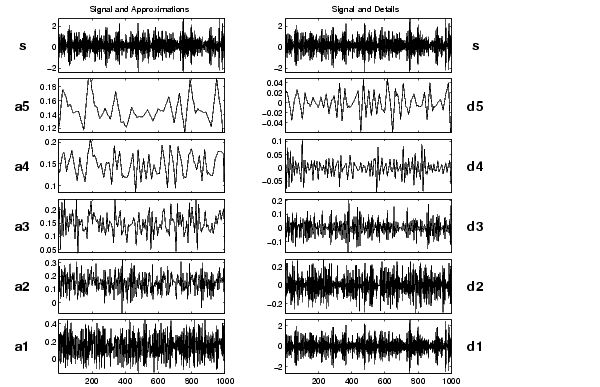| Wavelet Toolbox |
  |
Example 4: Colored AR(3) Noise
Analyzing wavelet: db3
Decomposition levels: 5
| Note
AR(3) means AutoRegressive model of order 3.
|
This figure can be examined in view of Example 3: Uniform White Noise, since we are confronted here with a non-white noise whose spectrum is mainly at the higher frequencies. Therefore, it is found primarily in D1, which contains the major portion of the signal. In this situation, which is commonly encountered in practice, the effects of the noise on the analysis decrease considerably more rapidly than in the case of white noise. In A3, A4, and A5, we encounter the same scheme as that in the analysis of  (see the table in Example 3: Uniform White Noise), the noise from which
(see the table in Example 3: Uniform White Noise), the noise from which  is built using linear filtering.
is built using linear filtering.

Example 4: Colored AR(3) Noise
|
Addressed topics
|
- Processing noise
- The relative importance of different details
- The relative importance of D1 and A1
|
Further exploration
|
- Compare the detail frequencies with those in the approximations.
- Compare approximations A3, A4, and A5 with those shown in Example 3: Uniform White Noise.
- Replace AR(3) with an ARMA (AutoRegressive Moving Average) model noise. For instance,

- Study an ARIMA (Integrated ARMA) model noise. For instance,

- Check that each detail can be modeled by an ARMA process.
|
 | Example 3: Uniform White Noise | | Example 5: Polynomial + White Noise |  |




 (see the table in Example 3: Uniform White Noise), the noise from which
(see the table in Example 3: Uniform White Noise), the noise from which  is built using linear filtering.
is built using linear filtering.
